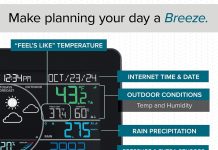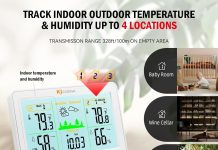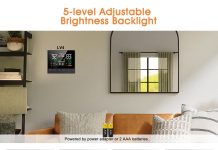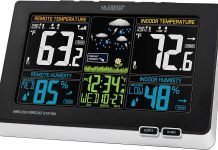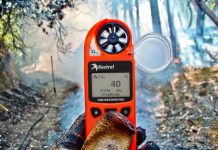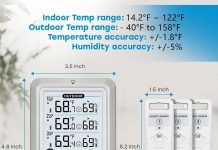Curious about the price of a basic home weather station? Look no further! In this article, we will explore the cost of setting up your very own weather station at home, so you can stay informed about the local conditions and plan your day accordingly. From budget-friendly options to more advanced models, we have got you covered. Join us as we uncover the prices and features of basic home weather stations, helping you make an informed decision that suits both your needs and your wallet.
Review contents
Factors that Impact the Cost of a Basic Home Weather Station
When considering the cost of a basic home weather station, there are several factors to take into account. These factors can vary from the type of sensors used in the weather station, the accuracy and precision of the readings, the wireless connectivity options available, the data logging and recording capabilities, and any extra features that the weather station may offer.
Type of Sensors
One of the key factors that impact the cost of a basic home weather station is the type of sensors it uses. Different weather stations will have different sensors to measure temperature, humidity, barometric pressure, wind speed, and rainfall. The more sensors a weather station has, the higher the cost is likely to be. For example, a weather station with just a temperature and humidity sensor may be less expensive than one with all the aforementioned sensors.
Accuracy and Precision
Accurate and precise measurements are essential for a weather station to provide reliable data. Weather stations with higher accuracy and precision tend to cost more than those with lower accuracy. The level of accuracy required may also depend on your specific needs. If you are a weather enthusiast or a professional meteorologist, investing in a weather station with higher accuracy may be worth considering. However, for basic home use, a weather station with moderate accuracy and precision should suffice.
Wireless Connectivity
Wireless connectivity is an important feature that allows you to remotely access and monitor the data collected by the weather station. Some weather stations can connect to Wi-Fi networks, while others may rely on specific wireless protocols. The availability of wireless connectivity can affect the cost of the weather station. Weather stations with Wi-Fi capabilities tend to be more expensive due to the added convenience and ease of data access.
Data Logging and Recording
The ability to log and record weather data is another factor that can impact the cost of a basic home weather station. Some weather stations offer built-in data logging and recording features, allowing you to store and analyze historical weather data. These weather stations often have larger internal storage capacities and more advanced data management options, which can contribute to a higher price point.
Extra Features
Basic home weather stations may also offer additional features that can influence the cost. These extra features can include wind direction indicators, UV index monitoring, solar radiation sensors, storm alerts, and more. While these additional features can enhance the functionality and usefulness of the weather station, they can also contribute to a higher price. Assessing your specific needs and preferences will help determine if these extra features are worth the additional cost.
Price Ranges for Basic Home Weather Stations
When it comes to the cost of basic home weather stations, they can generally be categorized into three price ranges: low-end, mid-range, and high-end. Understanding these price ranges can give you an idea of what to expect when shopping for a weather station.
Low-End Weather Stations (Under $50)
Low-end weather stations typically offer basic weather monitoring features and may have limited accuracy and functionality. They often have fewer sensors and may lack wireless connectivity options. These weather stations are suitable for casual users who want to get a general idea of the local weather conditions without breaking the bank. While they may not have all the bells and whistles, they can still provide useful information about temperature, humidity, and barometric pressure.
Mid-Range Weather Stations ($50 – $200)
Mid-range weather stations offer a balance between affordability and functionality. They usually come equipped with a broader range of sensors, allowing for more comprehensive weather monitoring. These weather stations often offer wireless connectivity, enabling you to access and analyze weather data remotely. They may also provide more advanced data logging and recording capabilities compared to low-end models. With increased accuracy and additional features, mid-range weather stations cater to weather enthusiasts and hobbyists who require more detailed weather information.
High-End Weather Stations (Above $200)
High-end weather stations are designed for professional meteorologists, researchers, and weather enthusiasts who demand the highest level of accuracy and precision. These weather stations have a wide range of sensors, including those for wind speed, rainfall, UV index, and solar radiation. They offer advanced data logging and recording features, along with seamless wireless connectivity. High-end weather stations are built to withstand harsh weather conditions and provide reliable and accurate data for analysis.
Factors to Consider when Choosing a Basic Home Weather Station
When selecting a basic home weather station, there are several factors that you should consider. These factors can help ensure that you choose a weather station that best suits your needs.
Accuracy and Reliability
Accuracy and reliability are crucial when it comes to a weather station. Look for weather stations that have been tested and validated for their accuracy. It is also important to consider the reliability of the brand and the sensors used. Reading customer reviews and ratings can provide valuable insights into the accuracy and reliability of a weather station.
Ease of Use and Installation
Consider how easy the weather station is to set up and use. Look for weather stations that come with clear instructions and intuitive interfaces. Wireless connectivity can also contribute to ease of use, as it allows for seamless integration with your smartphone or computer. Additionally, consider the installation process and whether you will require any additional tools or expertise.
Compatibility and Integration
If you already have other smart home devices or weather monitoring systems, compatibility and integration become essential factors to consider. Ensure that the weather station you choose can seamlessly integrate with your existing devices and software. This will allow you to consolidate and access all of your weather data from one central location.
Durability and Weather Resistance
Since weather stations are typically installed outdoors, it is important to choose a weather-resistant and durable model that can withstand various weather conditions. Look for weather stations that are built with robust materials and have a high level of weather resistance. Pay attention to features such as waterproofing, UV protection, and corrosion resistance.
Support and Warranty
Consider the support and warranty provided by the weather station manufacturer. It is important to have access to technical support in case you encounter any issues or have questions about the device. A warranty will provide peace of mind and protection against any manufacturing defects or malfunctions.
Popularity of Basic Home Weather Stations
Basic home weather stations have gained popularity in recent years due to various factors. Understanding the reasons behind their increased demand can help you grasp the relevance and usefulness of these devices.
Increased Demand
With the rise of smart homes and the growing interest in personal weather monitoring, the demand for basic home weather stations has significantly increased. These weather stations allow individuals to gather real-time weather data specific to their location, providing a sense of control and preparedness.
Consumer Reviews and Ratings
The availability of online platforms allows consumers to share their experiences and opinions about different weather stations. Positive reviews and high ratings from satisfied customers can influence the popularity of a particular weather station. Consumers often rely on the experiences of others when making purchasing decisions, making these reviews an important factor in the popularity of basic home weather stations.
Market Trends
The market for basic home weather stations is influenced by emerging trends in technology, such as the Internet of Things (IoT) and the increasing prevalence of smart home devices. As these technologies continue to evolve and become more accessible, the popularity of basic home weather stations is likely to grow. Manufacturers are also incorporating innovative features and functionalities to appeal to a wider audience and stay competitive in the market.
Where to Buy Basic Home Weather Stations
Basic home weather stations can be purchased from various sources, including online retailers, specialty weather stores, and local electronics stores. Each purchasing option has its own advantages and considerations.
Online Retailers
Online retailers such as Amazon, eBay, and specialized weather-focused websites offer a wide range of basic home weather stations. They provide access to customer reviews, ratings, and detailed product descriptions. Online shopping often provides a larger selection and competitive pricing. However, it is important to research the seller and read reviews to ensure a positive purchasing experience.
Specialty Weather Stores
Specialty weather stores, both online and brick-and-mortar, are dedicated to providing a wide range of weather-related products, including basic home weather stations. These stores often have knowledgeable staff who can provide guidance and recommendations based on your specific needs. Shopping at a specialty weather store can offer a more personalized experience and the opportunity to interact with experts in the field.
Local Electronics Stores
Many local electronics stores, such as Best Buy and RadioShack, also carry basic home weather stations. These stores may have a limited selection compared to online retailers or specialty weather stores. However, they offer the advantage of being able to physically see and interact with the weather stations before making a purchase. Additionally, local stores may offer after-sales support and immediate availability of the product.
Conclusion
When considering the cost of a basic home weather station, it is important to take into account factors such as the type of sensors used, accuracy and precision, wireless connectivity options, data logging capabilities, and extra features. Understanding the different price ranges for weather stations can give you an idea of what to expect when shopping. Consider the factors of accuracy and reliability, ease of use and installation, compatibility and integration, durability and weather resistance, as well as support and warranty when choosing a basic home weather station. The popularity of basic home weather stations has increased due to a growing demand, positive consumer reviews, and market trends. You can purchase basic home weather stations from online retailers, specialty weather stores, or local electronics stores. By considering all these factors, you will be able to choose a basic home weather station that suits your needs and budget.


